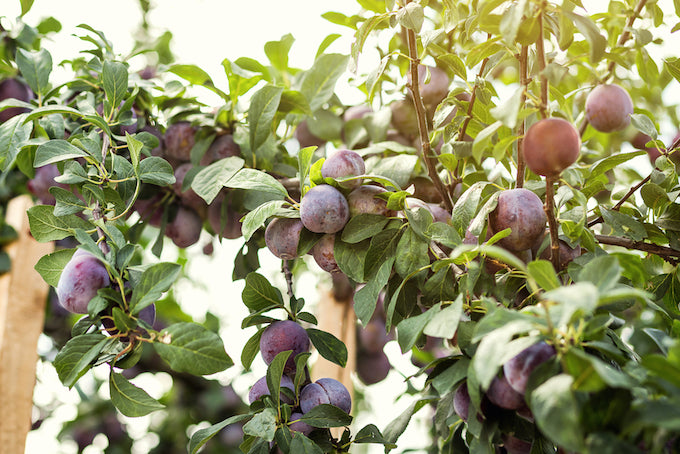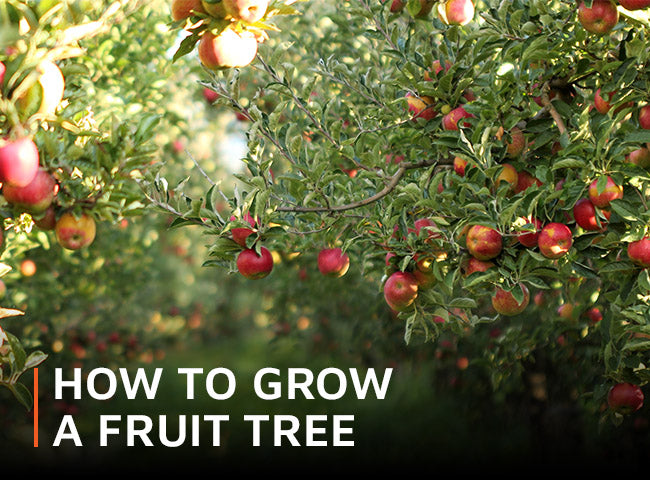Snacking on a juicy piece of fruit plucked from the branch of a homegrown tree is something to feel really smug about! Not to mention all the crumbles, chutneys and jams you can make with the windfalls. Here’s how to plant, grow and care for fruit trees in your garden or allotment.
What fruit tree should you plant?

Image source: Bondar Yuliia/Shutterstock
Don’t limit yourself to growing apples just because a bough of blushing braeburns adds bucolic charm to your garden. Consider plum, cherry or pear trees - or if you’re in a warmer area, why not try a fig or a peach tree for something more exotic? Not all varieties will bear fruit in British gardens but many feature beautiful blossom and can be kept to a manageable size.
When choosing your fruit tree, think about what you like to eat, and how much space and light you have in your garden. It’s important to consider what will grow well in your space, as well as the limitations of the climate you live in. If winter temperatures are very low, it’s no good trying to grow tropical or citrus varieties that won’t survive the frost.
Large fruit trees need space, and may eventually overshadow a smaller garden. If you have limited space, look at semi-dwarf and dwarf varieties. Some of these can even be grown in pots. It’s possible to train some fruit trees against a flat wall or fence, which is known as espalier, so if your space is very limited consider giving this a try.
Be aware that some trees - especially apple - aren’t self pollinating, so to produce fruit they need to be partner planted with a cross-pollinator. Check the variety before you buy. Even if you don't have space for two fruit trees in your own garden, bees, birds and other pollinators visiting neighbouring gardens will often do the trick for you.
Ten fruit trees to grow in the UK
- Apple - a classic fruit tree that grows well in Britain. With over 2,500 varieties there’s one to suit every garden.
- Pear - choose from dessert varieties or cookers. A good companion tree for apples.
- Plum - from delicate Victoria plums to decadent damsons, plum trees are surprisingly easy to grow and care for.
- Cherry - there are two main types of cherry - sweet (for eating) and acid (ideal for jam). They grow best in southern and central England.
- Fig - varieties that are happy growing in the UK include the Dalmatie or Brunswick. Planted for their architectural foliage as well as the fruit.
- Crab apple - edible varieties of these small, tart apples can be eaten but are more suited to cooking or making jam.
- Peach - grow as a fan on a south-facing wall, or in a patio container which can be moved to an unheated conservatory during winter.
- Apricot - the blossom will need protection from early frost but ‘Tomcot’ or ‘Flavorcot’ are two varieties that do well in the UK.
- Mulberry - rarely found in supermarkets, growing your own is the best way to get your hands on this juicy fruit, which grows on stunning, sculptural trees.
- Persimmon - Also known as sharon fruits, these exotic treats aren’t often seen in the UK, but in sunny and sheltered spots it’s possible for them to thrive.
When to plant fruit trees

Image source: tetiana_u/Shutterstock
A fruit tree is a longterm investment, so be patient. If you plant too early or leave it too late you’re better off waiting until the next suitable planting season.
Bare-root trees must be planted in the dormant season – from November to March. Check the ground isn’t frozen before you plant out. Container grown fruit trees are far more forgiving, but avoid planting between May and August.
Where to plant fruit trees

Image source: photowind/Shutterstock
As a rule, fruit trees need at least six hours of sunlight a day for a good crop, although there are varieties that will tolerate a little shade. If you’re planting in a courtyard or enclosed garden make sure there isn’t too much shelter. Choose a spot that gets plenty of rain so you don’t spend all your time watering it.
When finding a position for your tree, consider light, temperature and exposure levels - check what your chosen variety needs so you won’t have to relocate it in the future.
Be aware of the size it will reach as a mature tree. If you’re planting in an allotment or near vegetable beds, make sure your fully grown tree won’t cast too much shade over other crops.
And if you have limited space, there are many dwarf varieties of fruit trees that thrive in containers. The best fruits for container growing are apples and pears. If you want to grow plum trees in a pot, try ‘Blue Tit’, ‘Opal’ and ‘Victoria', which are self fertile.
How to plant a fruit tree in open ground

Image source: korkeng/Shutterstock
- Dig a hole large enough to comfortably fit the root ball - a good guide is ? wider than the roots. Leave the soil to one side.
- Most young fruit trees will need to be tied to a stake until they get established. Hammer the stake into the hole before planting the tree to avoid damaging roots.
- Find the soil mark or ‘collar’ on the trunk and make sure you plant the tree to the same depth. If in doubt, shallow is a safer bet than deep.
- Backfill the hole with the soil from the hole and gently firm with your feet.
- Water well.
- Cover the planting area with mulch.
- If you’re using a stake, fasten the tree with a rubber tie.
Tips for caring for your fruit tree

Image source: Stephane Bidouze/Shutterstock
- Protect young trees from wildlife with a tree tube.
- Apply a grease band half a metre above soil level to the stake and trunk of your tree to prevent pest infestations.
- Apply a plant-oil based winter wash in December or January to kill off pests.
- Weed every spring in the first few years of your tree’s life. Use bark chip around the base of the trunk to help prevent weeds from growing.
- Water during long dry spells. If in doubt, leaves are a great colour indicator of health - the darker the better.
- Remove blossom in first spring for a bumper crop the following year.
We hope you enjoy years of delicious fruit, fresh from your very own trees. Make a warming crumble or pie to deal with a glut, fill your pantry with homemade jams or try making cordials or cider for something a little different.
Lead image: Shutterstock




